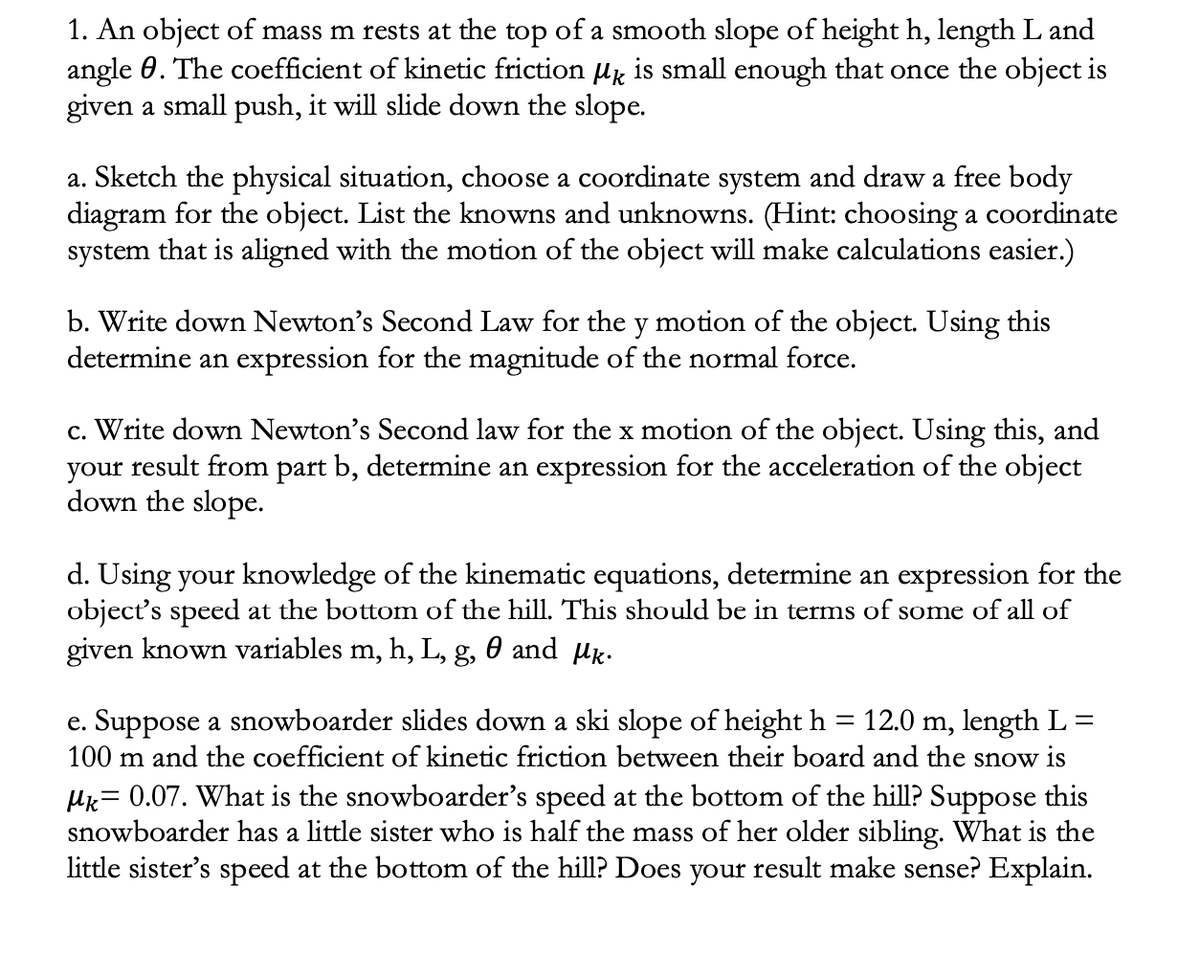1. An object of mass m rests at the top of a smooth slope of height h, length L and angle 0. The coefficient of kinetic friction ux is small enough that once the object is given a small push, it will slide down the slope. a. Sketch the physical situation, choose a coordinate system and draw a free body diagram for the object. List the knowns and unknowns. (Hint: choosing a coordinate system that is aligned with the motion of the object will make calculations easier.) b. Write down Newton's Second Law for the y motion of the object. Using this determine an expression for the magnitude of the normal force. c. Write down Newton's Second law for the x motion of the object. Using this, and your result from part b, determine an expression for the acceleration of the object down the slope.
1. An object of mass m rests at the top of a smooth slope of height h, length L and angle 0. The coefficient of kinetic friction ux is small enough that once the object is given a small push, it will slide down the slope. a. Sketch the physical situation, choose a coordinate system and draw a free body diagram for the object. List the knowns and unknowns. (Hint: choosing a coordinate system that is aligned with the motion of the object will make calculations easier.) b. Write down Newton's Second Law for the y motion of the object. Using this determine an expression for the magnitude of the normal force. c. Write down Newton's Second law for the x motion of the object. Using this, and your result from part b, determine an expression for the acceleration of the object down the slope.
Physics for Scientists and Engineers with Modern Physics
10th Edition
ISBN:9781337553292
Author:Raymond A. Serway, John W. Jewett
Publisher:Raymond A. Serway, John W. Jewett
Chapter7: Energy Of A System
Section: Chapter Questions
Problem 45AP
Related questions
Topic Video
Question
100%

Transcribed Image Text:1. An object of mass m rests at the top of a smooth slope of height h, length L and
angle 0. The coefficient of kinetic friction uk is small enough that once the object is
given a small push, it will slide down the slope.
a. Sketch the physical situation, choose a coordinate system and draw a free body
diagram for the object. List the knowns and unknowns. (Hint: choosing a coordinate
system that is aligned with the motion of the object will make calculations easier.)
b. Write down Newton's Second Law for the y motion of the object. Using this
determine an expression for the magnitude of the normal force.
c. Write down Newton's Second law for the x motion of the object. Using this, and
your result from part b, determine an expression for the acceleration of the object
down the slope.
d. Using your knowledge of the kinematic equations, determine an expression for the
object's speed at the bottom of the hill. This should be in terms of some of all of
given known variables m, h, L, g, 0 and µk.
e. Suppose a snowboarder slides down a ski slope of height h = 12.0 m, length L=
100 m and the coefficient of kinetic friction between their board and the snow is
Hk= 0.07. What is the snowboarder's speed at the bottom of the hill? Suppose this
snowboarder has a little sister who is half the mass of her older sibling. What is the
little sister's speed at the bottom of the hill? Does your result make sense? Explain.
Expert Solution
This question has been solved!
Explore an expertly crafted, step-by-step solution for a thorough understanding of key concepts.
This is a popular solution!
Trending now
This is a popular solution!
Step by step
Solved in 2 steps with 2 images

Knowledge Booster
Learn more about
Need a deep-dive on the concept behind this application? Look no further. Learn more about this topic, physics and related others by exploring similar questions and additional content below.Recommended textbooks for you

Physics for Scientists and Engineers with Modern …
Physics
ISBN:
9781337553292
Author:
Raymond A. Serway, John W. Jewett
Publisher:
Cengage Learning

Physics for Scientists and Engineers
Physics
ISBN:
9781337553278
Author:
Raymond A. Serway, John W. Jewett
Publisher:
Cengage Learning

College Physics
Physics
ISBN:
9781938168000
Author:
Paul Peter Urone, Roger Hinrichs
Publisher:
OpenStax College

Physics for Scientists and Engineers with Modern …
Physics
ISBN:
9781337553292
Author:
Raymond A. Serway, John W. Jewett
Publisher:
Cengage Learning

Physics for Scientists and Engineers
Physics
ISBN:
9781337553278
Author:
Raymond A. Serway, John W. Jewett
Publisher:
Cengage Learning

College Physics
Physics
ISBN:
9781938168000
Author:
Paul Peter Urone, Roger Hinrichs
Publisher:
OpenStax College

Principles of Physics: A Calculus-Based Text
Physics
ISBN:
9781133104261
Author:
Raymond A. Serway, John W. Jewett
Publisher:
Cengage Learning

University Physics Volume 1
Physics
ISBN:
9781938168277
Author:
William Moebs, Samuel J. Ling, Jeff Sanny
Publisher:
OpenStax - Rice University

Physics for Scientists and Engineers: Foundations…
Physics
ISBN:
9781133939146
Author:
Katz, Debora M.
Publisher:
Cengage Learning